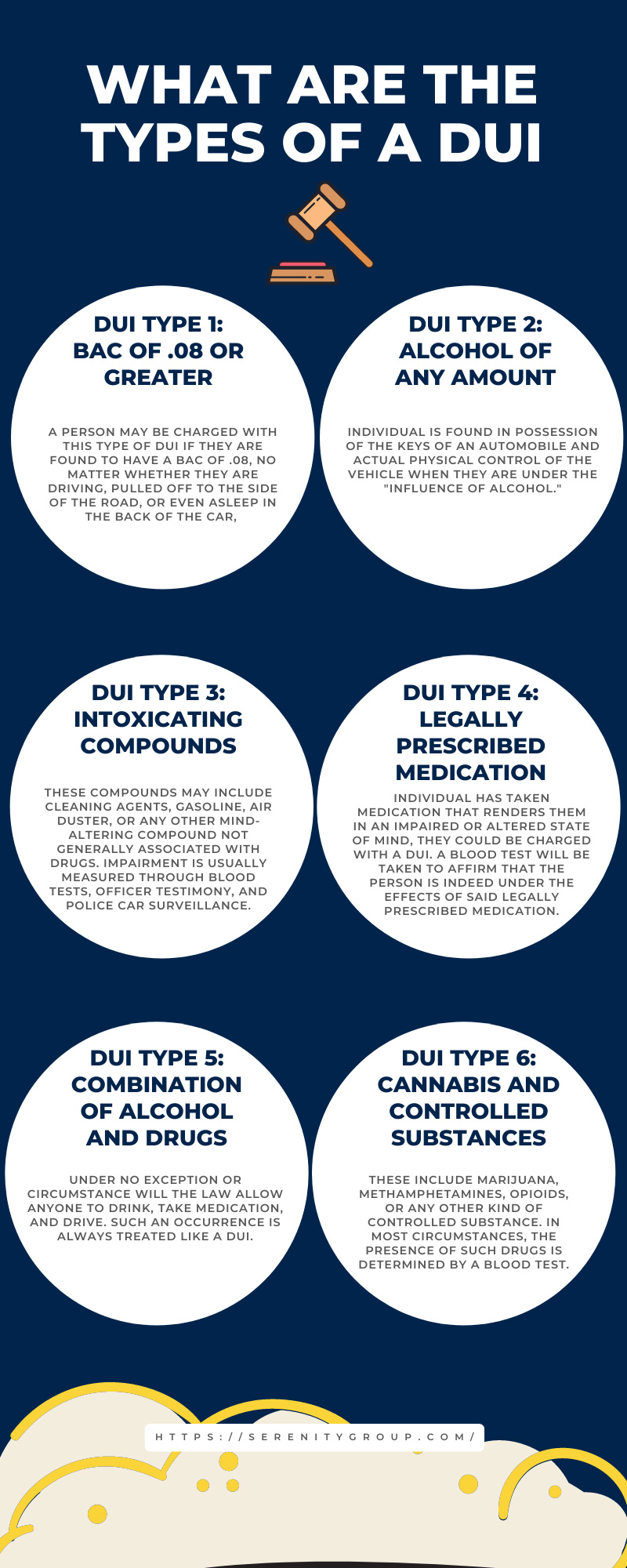What Are the Types of a DUI

When someone says DUI, the first thought in most people’s heads is the DUI of a .08 BAC or greater. While this may be the primarily advertised form of intoxicated driving, the legal definition of a DUI has evolved. As more mind-altering substances are legalized and developed in the US, the law also grows to reflect such substances. Many state governments are updating their legislature to include the verbiage of “driving while under the influence of alcohol, other drugs, intoxication compounds, or any combination thereof” to be more precise regarding the laws in place. Unfortunately, many people seem to have missed this legislative update, resulting in them being arrested for a DUI they had no intention of committing. To update you on what types of a DUI there are, here is an explanation of six different types.
DUI Type 1: BAC of .08 or Greater
Most people are familiar with the metric of BAC. BAC, which stands for blood alcohol content, is a metric that determines how intoxicated someone is based on the amount of alcohol in their bloodstream. In most cases, this is affirmed in three ways. The first way is a breathalyzer, which relies on the body’s metabolism of alcohol to assess the level of intoxicant in the blood. The second may be a blood test, which serves as a more long-term affirmation of intoxication. This is because alcohol remains in the bloodstream for up to 12 hours after a person has consumed the intoxicant. The third way BAC is measured is through a urine test, which can produce results for intoxication as much as 48 hours after ingestion.
The amount of alcohol it takes to reach a BAC of .08 is different for every person. This is because a person’s metabolism, height, weight, and even fitness level can be a determinant in the amount of alcohol required to make someone feel intoxicated. Due to the way the law works, a person may be charged with this type of DUI if they are found to have a BAC of .08, no matter whether they are driving, pulled off to the side of the road, or even asleep in the back of the car, assuming that the keys are in control of the individual at the time of their arrest.
DUI Type 2: Alcohol of Any Amount
This type of DUI offense happens when the individual is found in possession of the keys of an automobile and actual physical control of the vehicle when they are under the “influence of alcohol.” This could mean that the subject is under the legal limit of .08 but is exhibiting certain signs of drunkenness that could lead to unsafe driving. Without chemical testing, this type of DUI is harder to assert in court, as the police must prove that the amount of alcohol consumed relates to the unsafe driving practices that may have been exhibited. In these cases, a mix of officer testimony and video evidence is usually used to assert “unsafe conditions” and the impairment of the driver.
Dui Type 3: Intoxicating Compounds
This type of DUI refers explicitly to any intoxicating compound that renders a person physically unable to drive. These compounds may include cleaning agents, gasoline, air duster, or any other mind-altering compound not generally associated with drugs. In these cases, impairment is usually measured through blood tests, officer testimony, and police car surveillance.
DUI Type 4: Legally Prescribed Medication
Many people think that if they take a prescription legally, they are protected from any DUI charges. This could not be further from the truth. In reality, as long as an individual has taken medication that renders them in an impaired or altered state of mind, they could be charged with a DUI. In most circumstances, a blood test will be taken to affirm that the person is indeed under the effects of said legally prescribed medication.
DUI Type 5: Combination of Alcohol and Drugs
The fifth type of DUI requisites a mix of alcohol and drugs in a person’s system. In essence, the verbiage presented within the legislature is a catch-all for any combination of drugs or drugs mixed with alcohol. In most cases, simply the presence of those two substances in someone’s bloodstream is enough to charge them with a DUI, regardless of whether there is a visual presence of impairment. Most of the time, substances will be affirmed to be present with a blood test, as a breathalyzer will not tell the officer what compounds are present in the bloodstream. Another point of contention that seems to trip many people up is the legality concerning such things as opioid medication and alcohol in tandem with a seemingly unrelated accident.
To help make this clearer, let’s say Jodie took her legally prescribed painkiller and one hour later had a single glass of wine. She then goes to the market to get her groceries. A dog runs out into the street on the way there, and she crashes into a mailbox in an attempt to avoid hitting the dog. In this case, even though there was no visible outcome of her taking a drink after taking pain medication, she would still be charged with a DUI. Under no exception or circumstance will the law allow anyone to drink, take medication, and drive. Such an occurrence is always treated like a DUI.
DUI Type 6: Cannabis and Controlled Substances
The final type of DUI encompasses all other mind-altering substances not addressed in the provisions above. These include marijuana, methamphetamines, opioids, or any other kind of controlled substance. In most circumstances, the presence of such drugs is determined by a blood test. In most cases, even if one is not under the influence of a drug during the time an accident happens, but the blood test comes back positive for the drug, the case will still be treated like a DUI. Additionally, this statute does not refer to impairment. Rather, the simple presence of the drug is enough for the subject to be charged with a DUI. However, to be tested, one must first be involved in an accident. Under no circumstances are police allowed to test for drugs without probable cause.
It is important to remember that alcohol and drugs affect every single person differently. One drink for some may be equivalent to three for another, not to mention the difference in effect that such things as sleeping pills and alcohol have on different people. We hope that this guide will prevent you from wondering what types of DUI there are and will help you avoid any desire for intoxicated driving in the future. If you need SR22 high-risk insurance, contact Serenity Group for a competitive and fair quote.


Recent Comments